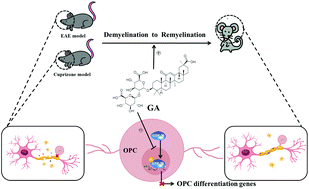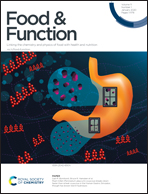Glycyrrhizic acid promotes neural repair by directly driving functional remyelination†
Abstract
Natural compounds are a rich source of effective candidate drugs for the treatment of neurological disorders. Glycyrrhizic acid (GA), the major water-soluble ingredient isolated from Glycyrrhiza glabra, is reported to show anti-inflammatory and immunomodulatory activities. However, its effect on CNS demyelinating disease is unclear. In this study, we showed that GA ameliorated the clinical disease severity of experimental autoimmune encephalomyelitis (EAE), an animal model of multiple sclerosis (MS), especially at the chronic stage of clinical EAE. Histological evaluation demonstrated that, in the prophylactic treatment regimen, GA significantly inhibited inflammatory demyelination in the CNS. During the chronic stage when myelin and axon damage has already occurred, GA induced oligodendrocyte progenitor cell (OPC) differentiation into mature oligodendrocytes, thus effectively accelerating remyelination. Evidence from the cuprizone-induced mouse model of de- and remyelination, ex vivo organotypic slice cultures, and in vitro OPC maturation experiments indicated that the observed efficacy of this compound resulted directly from enhanced remyelination rather than immune suppression. Furthermore, we found that GA promoted oligodendrocyte maturation through modulating GSK-3β signaling pathways. Our data led to the conclusion that GA could be used as a potential therapeutic candidate for the treatment of demyelinating diseases such as MS, which remains refractory to available treatments.



 Please wait while we load your content...
Please wait while we load your content...